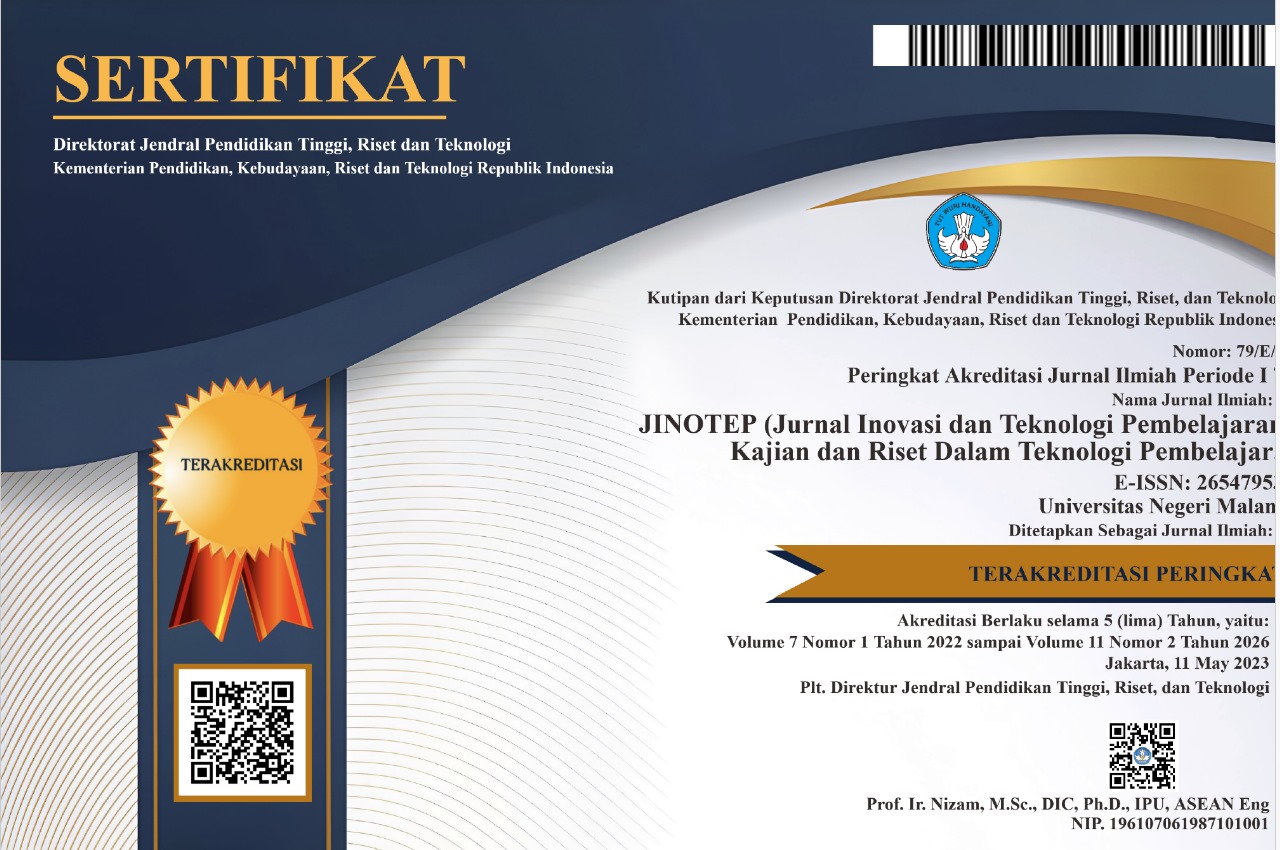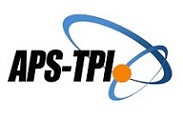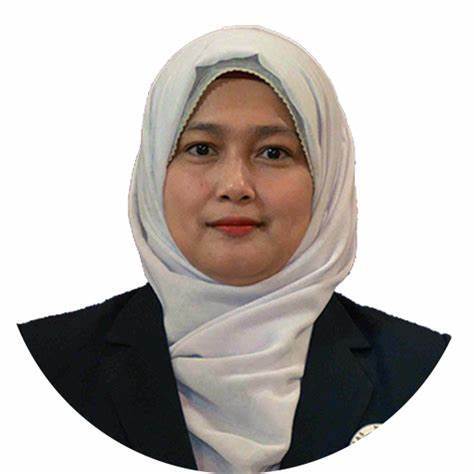Pengaruh Strategi Blended Learning Terhadap Hasil Belajar Mata Kuliah Sejarah Pendidikan Islam pada Mahasiswa yang Memiliki Locus of Control Berbeda
Abstract
Asbtrak: Tujuan penelitian ini adalah untuk menguji: (1) perbedaan perolehan hasil belajar (mengingat dan memahami konsep dan fakta) mahasiswa yang dibelajarkan dengan strategi pembelajaran blended learning dan strategi pembelajaran face to face (tatap muka secara langsung), (2) perbedaan hasil belajar (mengingat dan memahami konsep dan fakta) mahasiswa yang memiliki internal locus of control dan mahasiswa yang memiliki external locus of control, (3) interaksi antara penggunaan strategi pembelajaran blended learning dan face to face dengan locus of control terhadap hasil belajar (mengingat dan memahami konsep dan fakta) mata kuliah Sejarah Pendidikan Islam. Penelitian ini menggunakan metode a factorial (2x2) version of non equivalent control group design dengan mengambil tempat penelitian di UIN Sunan Ampel Surabaya yang dilaksanakan pada semester ganjil 2015/2016. Subjek penelitian sebanyak 124 orang pada semester 3 Fakultas Tarbiyah dan Keguruan Program Studi Pendidikan Agama Islam (PAI) dan Program Studi Pendidikan Guru MI (PGMI) yang tersebar dari 4 rombongan belajar (rombel) yang terbagi dalam 2 kelompok kelas eksperimen dan 2 kelompok kelas kontrol. Penetapan kelas eksperimen dan kelas kontrol dilakukan dengan teknik acak. Instrumen pengumpulan data menggunakan teknik angket dan tes. Subjek yang dianalisis berjumlah 84 pebelajar berdasarkan pada 33% kelompok internal locus of control dan 33% external locus of control, dengan menggunakan Analysis of Variance (ANOVA) 2 x 2. Hasil penelitian menunjukkan, bahwa: 1) Perolehan hasil belajar (mengingat dan memahami konsep dan fakta) mata kuliah Sejarah Pendidikan Islam antara kelompok mahasiswa yang dibelajarkan dengan strategi pembelajaran blended learning (face to face, online dan offline) dan strategi pembelajaran face to face (tatap muka secara langsung) menunjukkan adanya perbedaan yang signifikan. Hal ini dapat dibuktikan dengan nilai Fhitung = 98,880 dengan nilai probabilitas (p) = 0,000. 2) Perolehan hasil belajar (mengingat dan memahami konsep dan fakta) mata kuliah Sejarah Pendidikan Islam antara kelompok mahasiswa yang memiliki internal locus of control dan kelompok mahasiswa yang memiliki external locus of control menunjukkan adanya perbedaan yang signifikan, yang ditunjukkan dengan nilai Fhitung = 36,950 dengan nilai probabilitas (p) = 0,000, 3) Tidak terdapat pengaruh interaksi antara strategi pembelajaran blended learning (Face to face, online dan offline), strategi pembelajaran face to face (tatap muka secara langsung), dan locus of control terhadap hasil belajar (mengingat dan memahami konsep dan fakta) Sejarah Pendidikan Islam, yang dibuktikan dengan perolehan nilai Fhitung = 2,955 dengan nilai probabilitas (p) = 0,089.
Abstract: The purpose of this study is to examine: (1) differences in the acquisition of learning outcomes (remembering and understanding concepts and facts) of students who are taught with blended learning learning strategies and face to face learning strategies (face to face), (2) differences in learning outcomes ( remember and understand the concepts and facts) students who have internal locus of control and students who have external locus of control, (3) the interaction between the use of blended learning and face to face learning strategies with locus of control on learning outcomes (remembering and understanding concepts and facts) History of Islamic Education course. This study uses a factorial (2x2) version of non-equivalent control group design method by taking a place of research at Sunan Ampel UIN Surabaya which was held in the 2015/2016 odd semester. The research subjects were 124 people in the third semester of the Tarbiyah and Teacher Training Faculty of Islamic Education (PAI) Study Program and the MI Teacher Education Study Program (PGMI) which were spread out of 4 study groups divided into 2 experimental class groups and 2 control class groups. Determination of the experimental class and control class is done by random technique. The instrument of data collection uses questionnaire and test techniques. Subjects analyzed were 84 students based on 33% group internal locus of control and 33% external locus of control, using Analysis of Variance (ANOVA) 2x2. The results showed that: 1) Obtaining learning outcomes (remembering and understanding concepts and facts) History of Islamic Education courses between student groups taught with blended learning strategies (face to face, online and offline) and face-to-face (face-to-face) learning strategies show significant differences. This can be proven by the value of F-count = 98.880 with a probability value (p) = 0,000. 2) Obtaining learning outcomes (remembering and understanding concepts and facts) History of Islamic Education courses between groups of students who have internal locus of control and groups of students who have external locus of control indicate a significant difference, which is indicated by the value of F = 36,950 with probability value (p) = 0,000, 3) There is no interaction effect between blended learning strategies (Face to face, online and offline), face to face learning strategies (face to face face to face), and locus of control on learning outcomes (remembering and understanding the concepts and facts) History of Islamic Education, as evidenced by the acquisition of F-count = 2.955 with a probability value (p) = 0.089.
Keywords
Full Text:
PDFReferences
Akin, A. (2010). Achievement Goals and Academic Locus of Control: Structural Equation Modeling. Egitim Arastirmalari-Eurasian Journal of Education Research, 38, 1-18.
Allen, M. & W.M. Yen. (1979). Introduction to Measurement Theory. California: Brooks/Cole Publishing Company.
April, K.A, Dharani.B, & Peters.K. (2012). Impact of Locus of Control Expectancy on Level of WellBeing. Review of European Studies, 4 (2), 125-126
Ardhana, W. (1987). Bacaan Pilihan dalam Metode Penelitian Pendidikan. Jakarta: P2LPTK Ditjen Dikti Depdikbud.
Azwar, S. (2011a). Penyusunan Skala Psikologi. Yogyakarta: Pustaka Pelajar.
Azwar, S. (2011b). Tes Prestasi: Fungsi dan Pengembangan Pengukuran Prestasi Belajar. Yogyakarta: Pustaka Pelajar.
Bender, D. M., & Vredevoogd, J. D. (2006). Using Online Education Technologies to Support Studio Instruction. Educational Technology & Society, 9 (4), 114- 122.
Bonk, C.J & Graham, C.R. (2006). The Handbook of Blended Learning. San Francisco: John Wiley & Sons, Inc.
Brookover, W., Beady, C. Flood, P. Schweister, J, & Wisenbaker, J. (1979). School Social System and Student Achievement. New York: Praeger.
Carman, J. M. (2002). Blended Learning Design; Five Key Ingredient. New York: KnowledgeNet.
Chew, E. (2008). Book review: Blended Learning Tools for Teaching and Training. Educational Technology & Society, 11 (2), 344-347.
Degeng, I.N.S. (2000b). Pelatihan Pekerti. Malang: Universitas Negeri Malang Press.
Degeng, I.N.S. (1989c). Ilmu Pengajaran Taksonomi Variable. Jakarta: Departemen Pendidikan dan Kebudayaan Dirjen Dikti P2LPTK.
Driscoll, M. (2002a). Blended Learning: Let’s get beyond the hype. Diakses dari http://www.elearningmag.com/elea rning/article/articleDetail.jsp?id=11755 pada tanggal 3 Maret 2011
Dunn, R. (2001). Learning Style Differences of Nonconforming Middle-School Student. NASSP Bulletin, 2001; 85; 68. Diakses darihttp://bul.sagepub.com
Erez,T.A.J.A, Bono J.E, dan Thoresen C.J. (2002). Are Measures of SelfEsteem, Neuroticism, Locus of Control, and Generalized SelfEfficacy
Indicators of a Common Core Construct?. Journal of Personality and Social Psychology, 2002, vol. 83, No. 3, 693-710.
Gagne, R.M, Wager, W.W, Golas, K.C & Keller, J.M. (2005). Principles of Instructional Design. Belmont: Wadsworth.
Gall, M.D., Gall, J.P. & Borg, W.R. (2003). Educational Research: An Introduction. Seventh Edition. Boston: Pearson Education, Inc.
Graham, C. R. (2006). Blended Learning systems: Definiton, current trends, and future directions. Dalam C. J. Bonk and C. R.
Graham (Eds.), The handbook of blended learning:Global persepctives, local designs.San Francisco:Pfeiffer. pp. 3-21.
Heinich, R., Molenda, M., Russell, J. D., & Smaldino, S. E. (2002). Instructional Media and Technologies for Learning. Upper Saddle River, NJ: Pearson Education.
Hwang, W.-Y., Hsu, J.-L., Tretiakov, A., Chou, H.-W., & Lee, C.-Y. (2009). Intra-action, Interaction and Outeraction in blended learning environments. Educational Technology & Society, 12 (2), 222–239.
Inoue, Y. (2010). Cases on online and blended learning technologies in higher education : concepts and practices. New York: IGI Global
Kerlinger, F.N. (1986). Asas-asas Penelitian Behavioral. Terjemahan oleh Landung R. Simatupang. 1990. Yogyakarta: Gajah Mada University Press.
Lefcourt, H. (1976). Locus of Control; Current Trends in Research and Theory. Hillsdale, N.J.: Erlbaum.
Linn, R. L., (1989). Educational Measurement. New York: American Council on Education and McMilan Publishing.
Mayer, R.E. (2009). Multi-Media Learning; Prinsip-prinsip dan Aplikasi. Ter. Teguh Wahyu Utomo. Yogyakarta: Pustaka Pelajar.
Mousavi, S., Low, R., & Sweller, J. (1995). Reducing Cognitive Load by Mixing Auditory and Visual Presentation Modes. Journal of Educational Psychology, 87, 319-334.
Phares, E.J. (1976). Locus of Control in Personality. Morristown, NJ.:General Learning Press
Qasim, A. (2014). Learning from the Past; A Contentious Issue?. Jurnal Kajian Sejarah & Pendidikan Sejarah, 2 (1) Maret 2014. Hlm. 6
Salkind, J. N. (2006). Encyclopedia of Educational Psychology. New York: Sage Publications.
Schunk, D.H, Pintrich, P.R, & Meece, J.L. (2010). Motivation in Education; Theory, Research, and Applications. New Jersey: Pearson Education, Inc.
Sevilla, C.G. (1993). Pengantar Strategi Penelitian. Jakarta: UI Press.
Slavin, R.E. (1994). Educational Psychology; Theory and practice. Needham Heights: Allyn and Bacon.
Smaldino, S.E., Lowther, D.L, & Russell, J.D. (2008). Instructional Technology and Media for Learning. New Jersey: Pearson Education, Inc.
So, H.-J., & Bonk, C. J. (2010). Examining the Roles of Blended Learning Approaches in ComputerSupported Collaborative Learning (CSCL) Environments: A Delphi
Study. Educational Technology & Society, 13 (3), 189–200.
Sukisno. (2013). Pengaruh Strategi Pembelajaran Klarifikasi Nilai dan Locus of Control terhadap Hasil Belajar pendidikan Kewarganegaraan dan kemampuan Berpendapat Mahasiswa. (Disertasi) Program Pascasarjana Universitas Negeri Malang (Tidak Dipublikasikan).
Tuckman, W.B. (1999). Conducting Educational Research: Fifth Edition. New York: Harcourt Brace Jovanovich, Publisher.
Wilhite, S.C. (1990). Self-Efficacy, Locus of Control, Self-Assessment of Memory Ability, and Study Activities as Predictors of College Course Achievement. Journal of Educational Psychology Review, 82 (4), 696-700.
Williams, P. (2010). Beyond Control:Will Blended Learning Subvert National Curricula? Dalam Eugenia M.W.
Ng. (Ed.). Comparative blended learning practices and environments. New York: IGI Global.
Yemen, G & Clawson, J.G. (2003). Locus of Control. Charlottesville: the University of Virginia Darden School Foundation.
DOI: http://dx.doi.org/10.17977/um031v3i12016p072
Refbacks
- There are currently no refbacks.
Copyright (c) 2016 Sihabudin

This work is licensed under a Creative Commons Attribution-ShareAlike 4.0 International License.
======================================================================
Jurnal Inovasi dan Teknologi Pembelajaran published by Universitas Negeri Malang in collaboration with the Asosiasi Program Studi Teknologi Pendidikan Indonesia (APS TPI) and Ikatan Profesi Teknologi Pendidikan Indonesia (IPTPI) with a MoU.
Publisher Address:
Educational Technology Laboratorium, Building D5, 1st Floor
Faculty of Education, Universitas Negeri Malang
Semarang St. No. 5, Malang City, East Java Province, Postal Code 65145
Email: jinotep.fip@um.ac.id
======================================================================

JINOTEP is licensed under a Creative Commons Attribution-ShareAlike 4.0 International License.
JINOTEP Statistics (Since July 13th, 2020)


.png)




.png)
1.png)
1.png)
4.png)
2.png)
1.png)
1.png)
.png)


_3.png)





1.png)
.png)